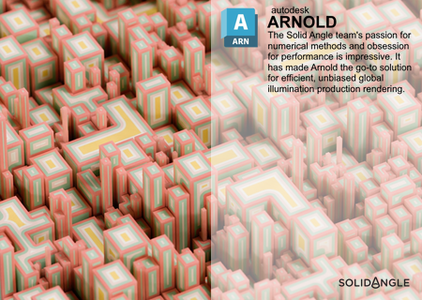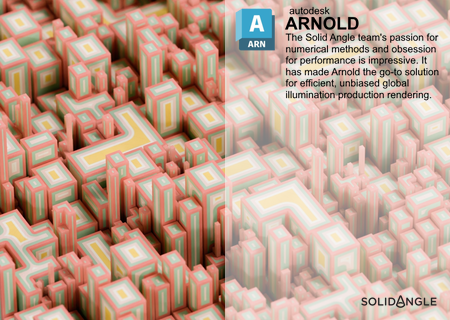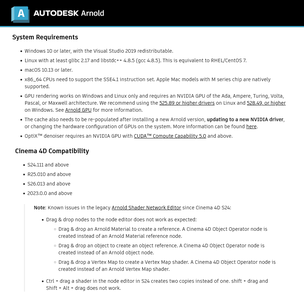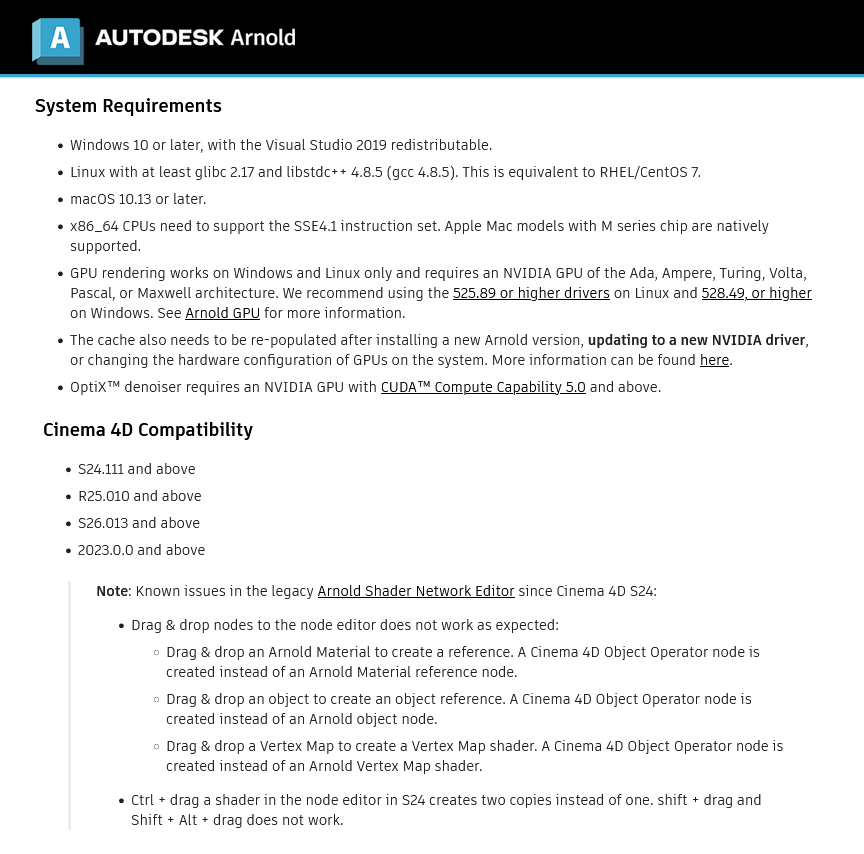Solid Angle Cinema 4D to Arnold 4.6.2 | 5.4 Gb
The Team Solid Angle announced the launch of Arnold (C4DtoA) 4.6.2 for Cinema4D. This update uses Arnold 7.2.1.1 and is a minor feature release bringing Pyro render performance improvements and a number of bug fixes.
4.6.2 - Date: 19 April 2023
Enhancements
Pyro render performance improvements: Faster initialization and reduced memory usage, when rendering an uncached Pyro simulation. In our test scenes we've seen 1.25x faster scene initialization and 2.85x less memory usage on average. (C4DTOA-2963)
Pyro GPU render: Uncached Pyro simulation can now be rendered on the GPU. (C4DTOA-2963)
Density and emission in default Pyro volume shader: Density and emission in the default Pyro volume shader (when no shader is assigned to the Pyro object) is now adjusted based on the Cinema 4D and Arnold project scale. For instance, if the Cinema 4D project is in centimeters and the Arnold scene is in meters, density and emission is scaled up 100x. This change does not affect old scenes. (C4DTOA-2967)
Optimized Arnold Sky viewport display: Faster viewport display of HDRIs, when the texture is defined with a relative path. (C4DTOA-2972)
Global matrix in the object shader: The object shader can now output the transformation matrix of the referenced object, that can be connected to any matrix type input, such as uv_transform.matrix. (C4DTOA-2973)
Motion blur with set_transform: The set_transform operator now has a matrix attribute, that can be animated and driven by any object from the scene. This allows set_transform to apply animations and get correct motion blur. (C4DTOA-2945)
Bug Fixes
C4DTOA-2872 - Random crash in the legacy node editor after undo
C4DTOA-2874 - Rare IPR crash when adding new tags to the scene
C4DTOA-2884 - Rare crash when redrawing image in the IPR window
C4DTOA-2962 - Crash when closing the IPR window while the scene is updating
ARNOLD-13043 - DeepEXR and Cryptomatte use more memory than needed
ARNOLD-13128 - Node init and update happens twice when doing a negative AA progressive render
ARNOLD-13367 - Opacity mask texture performance scaling regression
ARNOLD-13397 - Crash report sent when Arnold is not used
ARNOLD-13446 - Crash with extremely small triangles near the origin
ARNOLD-13434 - [usd] Sublayer loading errors on Windows
ARNOLD-9497 - [GPU] coat_direct, coat_indirect, and other diffuse/translucent AOVs are incorrect
ARNOLD-13377 - [GPU] Output warning instead of error when unable to create child node of procedural
usd#1485 - MaterialX shader nodes should have "auto" colorspace by default
usd#1459 - Support shaders with multiple outputs
usd#1359 - Refresh the Arnold instancer when the prototype mesh points have changed
usd#1483 - Indexed normals with vertex interpolation are now converted properly
usd#1462 - Ensure shader scope doesn't appear twice in the hierarchy
usd#1477 - Fix the motion blur with interframe geometry samples in the render delegate
usd#1419 - Add a note in the README about the USD_ASSIGN_PROTOTYPES_DETERMINISTICALLY environment variable, which fixes the flickering instances in cryptomatte issue
usd#1426 - Skinned transforms are now correctly used on the skinned meshes
Arnold is an advanced cross-platform rendering library, or API, developed by Solid Angle and used by a number of prominent organizations in film, television and animation, including Sony Pictures Imageworks. It was developed as a photo-realistic, physically-based ray tracing alternative to traditional scanline based rendering software for CG animation. Arnold uses cutting-edge algorithms that make the most effective use of your computer’s hardware resources: memory, disk space, multiple processor cores, and SIMD/SSE units. The Arnold architecture was designed to easily adapt to existing pipelines. It is built on top of a pluggable node system; users can extend and customize the system by writing new shaders, cameras, filters and output driver nodes, as well as procedural geometry, custom ray types and user-defined geometric data. The primary goal of the Arnold architecture is to provide a complete solution as a primary renderer for animation and visual effects.
Arnold for Cinema4D (C4DtoA) supports most Cinema 4D features such as instances, cloners, deformers, generators, MoGraph geometry, hair, and ThinkingParticles. It also supports both animation and single frame distributed rendering in Team Render, allowing the use of all computers in a local network to speed-up Arnold rendering. Third-party plugins TurbulenceFD and X-Particles are natively supported, allowing artists to render high quality smoke, fire, and particle effects with fully interactive feedback. Other features include volume rendering with OpenVDB, a node-based material editor and a comprehensive list of shaders and utilities, including vertex maps and per-face materials.
The Ultimate Introduction to Arnold 6 (& 7) For Cinema 4d
Solid Angle SL is the technology company behind the Arnold rendering software, with offices in Madrid and London and customers throughout the world including Framestore, DreamWorks, ILM, Sony Pictures Imageworks, MPC, The Mill, Mikros Image and Rising Sun Pictures. Arnold was designed from the ground up to efficiently raytrace the complex geometric datasets required for feature-length CGI animation and big budget visual effects, while at the same time simplifying the pipeline, reducing the number of passes, minimizing storage requirements and greatly enhancing interactivity for lighting artists.
Product: Solid Angle Cinema4D to Arnold
Version: 4.6.2
Supported Architectures: x64
Website Home Page : www.arnoldrenderer.com
Languages Supported: english
System Requirements: Windows / macOs / Linux *
Size: 5.4 Gb
Please visit my blog
Added by 3% of the overall size of the archive of information for the restoration
No mirrors please
Added by 3% of the overall size of the archive of information for the restoration
No mirrors please







